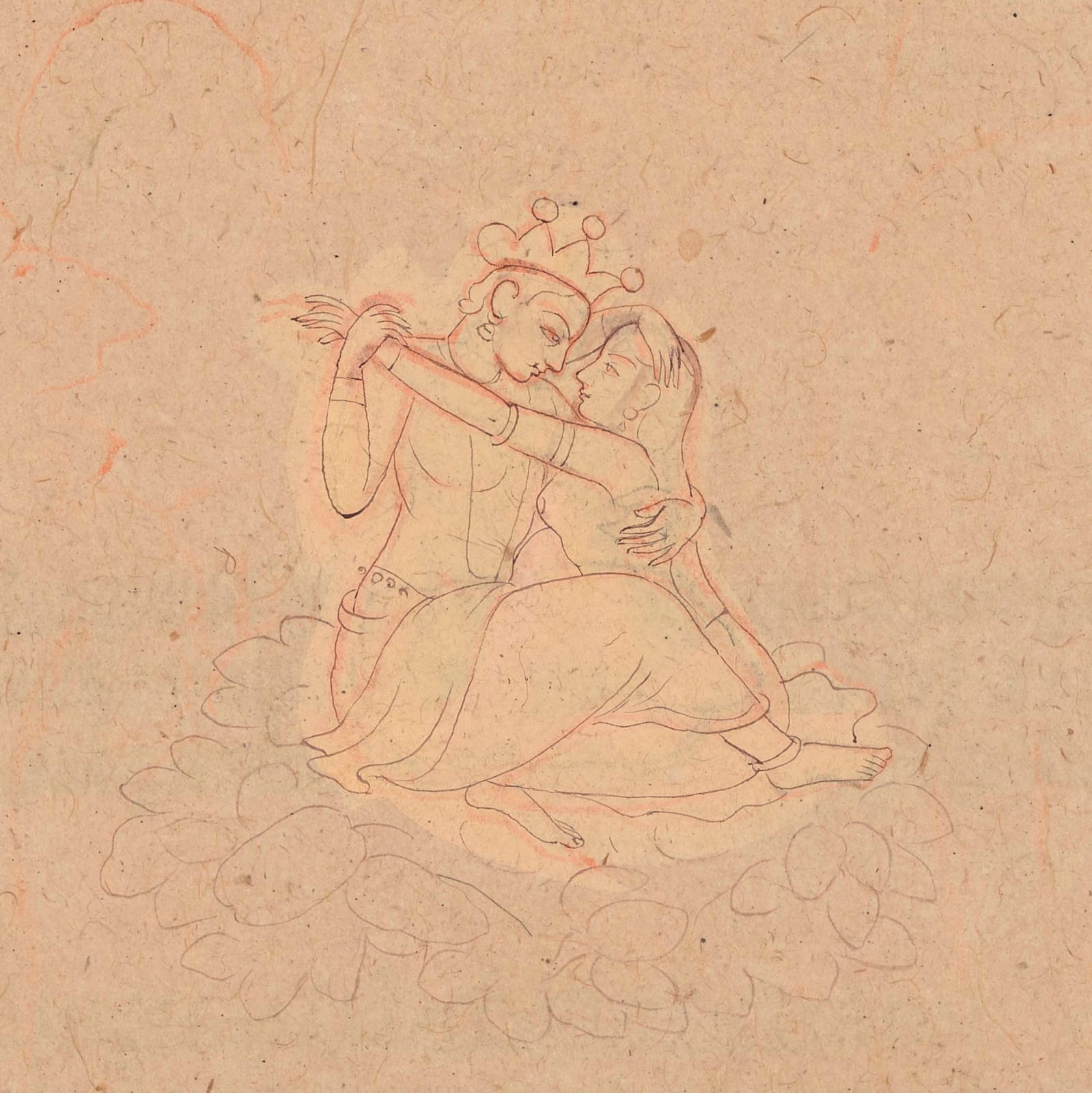Vishnu and Shri embracing
Original outlines attributed to Nainsukh, c. 1765, with additions by his sons and nephews
Brush drawing in red sanguine and dark brown with pink-yellow wash
Inscribed on the reverse in Devanagari with the Sanskrit text of Jayadeva’s Gitagovinda I, 25, and a Pahari paraphrase, and the folio number 24 above and another number 21 below.
Although the couple engaged in a passionate embrace would seem to be Krishna and Radha, the verse that this erotic coupling illustrates is in fact from the first canto of Jayadeva’s Gitagovinda, the last verse of a paean to Vishnu as the preserver
of the world:
“As he rests in Shri’s embrace, on the soft slope of her breast, The saffroned chest of Madhu’s killer is stained with red marks of passion And sweat from fatigue of tumultuous loving. May his broad chest bring you pleasure too!”
(translation Miller 1977/1984, p. 73)
The god’s crown without the peacock finial always worn by Krishna in this series, also absent in the finished painting, serves to tell us that this is in fact Vishnu not Krishna. The drawing does not quite correspond to the text, for it is Vishnu who is supporting Shri in their post-coital embrace, with one hand behind her back and the other holding her wrist as she clings to his shoulder. Her other hand is pulling back her orhni from her forehead the better to gaze into his eyes in this moment of tender intimacy. The drawing is from a set of preparatory drawings for the ‘Second Guler’ Gitagovinda, now dispersed. They all have the Sanskrit text of the poem on the reverse together with a commentary/paraphrase in a Pahari dialect. Here the text is obviously relevant to the drawing on the other side, although that is not universally so in this set of drawings. The finished painting for this drawing is in the Kronos collection in New York (McInerney 2016, no. 81).
Two earlier pages of sketches apparently noting down Nainsukh’s first thoughts on how Radha should appear in this set have survived, in the Museum Rietberg and the National Museum, New Delhi (Goswamy 1997, nos. 98 and 99). Each has three or four drawings of Radha in various postures, while the beginning of the Sanskrit verse of the Gitagovinda relevant to the drawing is written on the other side. In the next stage in the preparation of the set, i.e. the stage represented by our drawing, Nainsukh worked out the rough outline of the contents of each painting. A very free preliminary broad outline of the subject in red sanguine was done, noting the position of the loving couple and the broad outline of the landscape. Next came the addition of a light yellow wash over the underdrawing of the figures, intended as a ground for the finer drawing of outlines in deep brown achieved with firmer and more precise drawing with a much finer brush. The bed of leaves on which they are sitting was also put in at this stage. In the various drawings in the set, some of this stage is very fine, some less so. It is extremely finely done in our example, Vishnu being the very epitome of manly grace and Shri of womanly devotion as they gaze tenderly at each other.
It is a moot point whether and to what extent Nainsukh was involved at this stage or whether this was done by one or other of the sons and nephews, while he thought about his next project. Certainly the short-nosed high-foreheaded profiles of Vishnu and Shri match those in paintings attributed to Nainsukh of Krishna and Radha enthroned (Goswamy 1997, figs. 44 and 90).
The number of each sheet was usually put at the top and repeated on the reverse. Finally a rectangle of firm black lines was ruled round the drawing intended to represent no doubt the area to be painted in full, but later generally ignored. For Nainsukh’s involvement in the preparation of this set, see Goswamy 1997, pp. 246–51, and for an analysis of the drawings as a set see Losty 2017, pp. 147–63.
The drawings are working drawings often showing changes of mind. Vishnu’s left hand was first positioned a little higher up on Shri’s back, but then lowered a little to be at a more natural angle following the line of the shoulder and the upper arm. In the finished painting the hand has been lowered a little more and the wrist has disappeared. In the drawing the position of Vishnu’s right leg has also changed, being originally higher up the page.
Provenance
Private Collection, USA’
Ludwig Habighorst collection
Exhibitions
Der Blaue Gott in indischen Miniaturen, Mittelrhein Museum, Koblenz, 26.7. – 5.10.2014Literature
Goswamy, B.N., Nainsukh of Guler, Artibus Asiae Suppl. XLI, Museum Rietberg, Zurich, 1997
Habighorst, L.V., Der blaue Gott in indischen Miniaturen, Mittelrhein Museum, Koblenz, 2014,
Losty, J.P., A Mystical Realm of Love - Pahari Paintings from the Eva and Konrad Seitz Collection, Francesca Galloway, London, 2017
McInerney, T., et al., Divine Pleasures: Paintings from India’s Rajput Courts, the Kronos Collection, The Metropolitan Museum, New York., 2016
Miller, B.S., Love Song of the Dark Lord, Columbia University Press, New York, 1977 (first Indian edition, Delhi, 1984)



